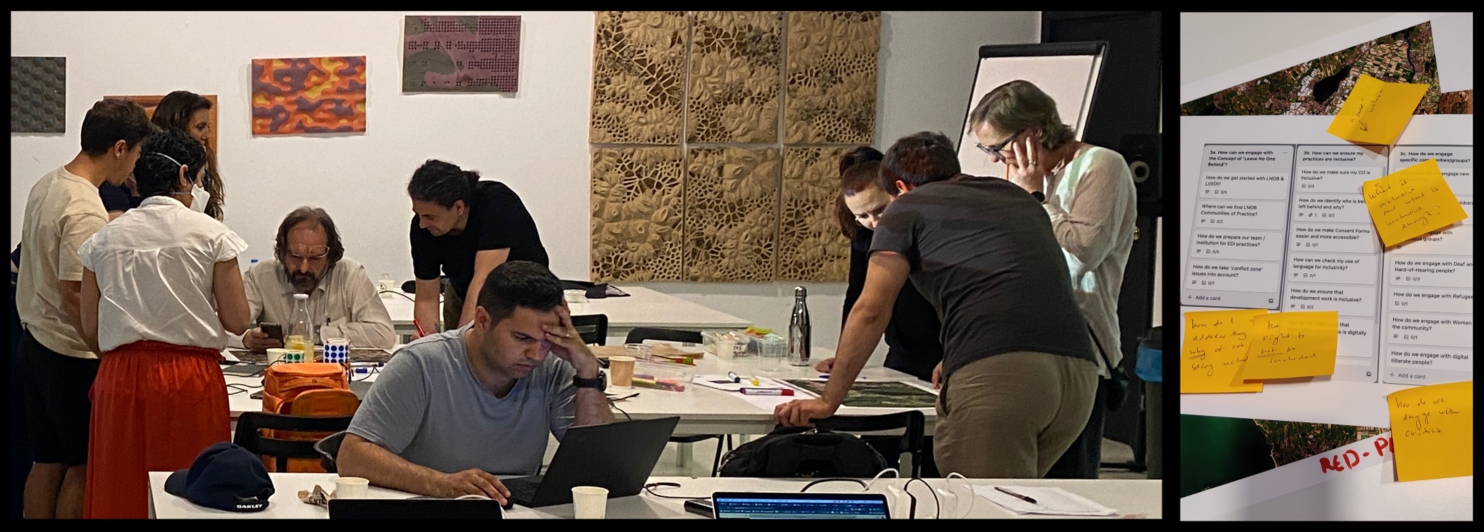Consortium Partner Margaret Gold reflects on the foundations for equality, diversity and inclusion being laid in the project during the first half year.

Margaret Gold
Margaret Gold, Leiden University, August 2023
One of the central aims of the CitiObs project is to engage diverse groups of people in becoming more aware of environmental issues in the places that they live and work, involving them in observation and monitoring activities such as measuring air quality, and collaborating together on actions or solutions to tackle these issues. Because these types of issues often affect some groups of people unequally – and also inequitably – the CitiObs consortium is collating best practice mechanisms for inclusive engagement in the pursuit of leaving no one behind.
Thinking inclusively means having attention for the kinds of groups found in urban communities, across all cultures, genders, and ages; and having attention for groups of people that might not usually be involved or experience barriers to participation in Citizen Observatories (COs), such as people from ethnic and cultural minorities, and people with mobility challenges.
Building the foundations for equity, diversity and inclusion in COs.
One of the first tasks within the project is therefore to bundle together best practice guidance and tools within a ‘Leave No One Behind’ Toolkit, which will serve the foundations for empowerment, inclusiveness and equity in the activities of the COs that will start to become more active towards the end of the first year of the project. We are particularly interested in collating recommendations, tools, and approaches for the diverse and representative inclusion of citizens across the dimensions of gender, sociocultural origin, religious affiliation, literacy levels, social status, and age, and to engage women, disabled groups, and ethnic minorities.
At the 2nd full-consortium workshops held at the beginning of the summer of 2023 in Barcelona, the consortium partners learned more about the ‘Leave No One Behind’ concept and worked together on bringing that thinking into urban contexts where environmental issues can impact different groups of people unequally and inequitably.

PHOTO: CitiObs consortium partners at the Barcelona plenary workshop exploring the ‘Leave No One Behind’ concepts
Where does the ‘Leave No One Behind’ concept come from, and what does it mean?
In 2015, the 193 Member States of the United Nations pledged to ensure “no one will be left behind” and to “endeavour to reach the furthest behind first” when they approved the 2030 Agenda for Sustainable Development2. The intention of this pledge is for Member States to take explicit action to eradicate poverty in all its forms, end discrimination and exclusion, and reduce the inequalities and vulnerabilities that leave people behind and undermine the potential of individuals and humanity as a whole, as well as to fast-track progress for the furthest behind.
The United Nations Development Programme (UNDP), which works with countries to implement the 2030 Agenda, has defined five key factors that help to understand who is being left behind and why: (1) Discrimination, (2) Geography, (3) Governance, (4) Socio-economic status, and (5) Shocks and Fragility. People at the intersection of these factors face reinforcing and compounding disadvantage and deprivation that can cause them to be among the furthest behind3.
“People get left behind when they lack the choices and opportunities to participate in and benefit from development progress. All persons living in extreme poverty can thus be considered ‘left behind’, as can those who endure disadvantages or deprivations that limit their choices and opportunities relative to others in society.4”
The concept of ‘Leave No One Behind’ recognises that to achieve the UN Sustainable Development Goals (SDGs) defined in the 2030 Agenda, it is necessary for the people who are being left behind to become full and equal agents in achieving these goals, with meaningful participation in decision making, underpinned by safe and inclusive mechanisms for their civic engagement.
The UNDP furthermore defines three mutually reinforcing “levers” that are required to ensure that no one is left behind, namely:
1. Examine: disaggregated and people driven data and information,
2. Empower: civic engagement and voice, and
3. Enact: integrated, equity-focused SDG policies, interventions, and budgets5.
Making use of these levers, CitiObs has an opportunity to play a role in empowering those who are left behind to (1) gather, analyse use data and evidence of the environmental factors that impact their lives negatively; (2) expand the opportunities to engage as city residents and members of civil society with local and regional decision makers who can act on that data towards the achievement of the SDGs; and (3) to co-develop and co-promote policies and interventions that will improve both their living environment and opportunities for the furthest behind people, groups and communities.

Image Source: LEAVE NO ONE BEHIND: THE SUSTAINABLE DEVELOPMENT GOALS IN 3 MINUTES - VIDEO
Taking a co-creative approach to laying these foundations
Margaret Gold at Leiden University is leading this aspect of the CitiObs project together with her colleagues in the Citizen Science Lab, Andrea Reyes Elizondo and Anouk Spelt:
“With co-creation and collaboration at the heart of the CitiObs ethos, we want to be doing this foundational work together with as many people as possible, from the Citizen Science community of practice via the ECSA ‘Equality, Inclusion and Equity’ Working Group, as well as other European projects currently engaged with these issues, via the European Citizen Science collaboration group. But also from other fields of practice – many other people active in sustainable development, public engagement with science, and social innovation have already been developing many best practices for inclusive and representative collaboration. We hope to sign-post these great resources within our LNOB Toolkit as a living document that keeps growing, and can be useful in many contexts.”
With a combination of desk research and collaborations with the wider Citizen Science community, the Leiden University team have been gathering guidance, tools and resources that can be helpful to community leaders in Citizen Observatories and aid them in building more diverse and inclusive communities of participants, who can thus have a stronger voice in issues relating to their own health and living environment.
The first draft of the Toolkit and its guidance for use in practice will be tested with the Frontrunner Cases in the first year of the CitiObs project, but will continue to be co-creatively developed throughout the entire lifetime of the project, and made publically available for global use.
If you’d like to join us in this work, or can point to useful resources that should be included, please get in touch with the team via our Contact Page.


